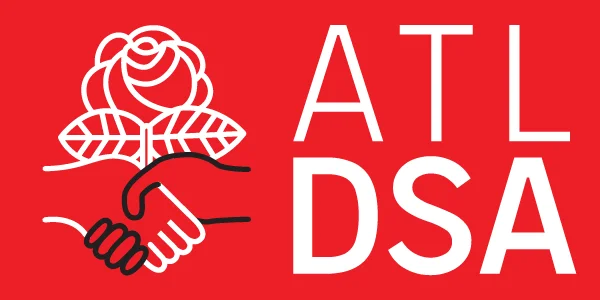

Statement on the Public Service Commission Democratic Primary Runoff
There is a Democratic primary runoff for the Georgia Public Service Commission on July 15, 2025. If you were registered to vote in Georgia as of May 19, you are eligible to vote in this runoff, regardless of where in Georgia you are or whether you voted in the June primary, unless you voted in the Republican primary. We recommend voting for Peter Hubbard, as he is the most qualified candidate and is likely to seek reelection to the office next year, and then serve a full term. This recommendation is not an endorsement from Atlanta DSA.
What is the PSC?
Georgia’s five-member Public Service Commission (PSC) oversees utilities and has the power to approve or deny requested rate increases, among other things. Currently, all five members are Republicans, and they are quite friendly to Georgia Power and the other industries they regulate. After a voting rights lawsuit was thrown out, special elections for two seats were scheduled for this year. All PSC members are elected statewide.
The PSC is supposed to make sure that Georgia Power doesn’t automatically get everything they want. Yet time and time again, they have approved rate hikes exactly as requested by Georgia Power. We need a Public Service Commission that actually serves the public, rather than giving a rubber stamp to utilities. The PSC also regulates usage for high-energy facilities like data centers and handles some long-term policy planning. In particular, the PSC has repeatedly approved rate hikes to pay for the two new reactors at Plant Vogtle, even as the project’s estimated time and cost continued to balloon. The reactors are now operational, but the public would have benefitted from a PSC that was more willing to ask hard questions about Georgia Power’s plans early on.
Who is on the Ballot?
The July 15 runoff is between clean energy advocate Peter Hubbard and former Atlanta City Council member Keisha Sean Waites. Hubbard is the founder of the Georgia Center for Energy Solutions, a nonprofit that advocates for a transition to a zero-carbon future. Hubbard has served as an intervenor in PSC rate cases, meaning that he files and argues in front of the PSC for a position that otherwise would not have been represented. He says that he is running because the PSC has ignored the evidence presented in favor of “cleaner, cheaper, and more reliable renewable energy”.
Hubbard combines the policy expertise and willingness to challenge powerful interests that we need on the PSC. In contrast, Waites openly admits she is not familiar with utility policy. Furthermore, this is the seventh office Waites has run for in the last ten years, and she has resigned from both of the offices she was successfully elected to in order to seek a different office (and lost). We would like to see a Public Service Commissioner who can be relied on to stay in the office and continue holding Georgia Power accountable for many years. We therefore recommend voting for Peter Hubbard.
When and How Can I Vote?
There is a Democratic primary runoff on July 15 and a general election on November 4. Early voting must begin in all counties by July 7, but some counties will start early voting earlier; it ends on July 11. At the polls, be sure to request a Democratic ballot. (In most of Georgia, there will not be any other type of ballot available.)
Where Can I Vote?
Because of low turnout in the June primary, there may be a limited number of voting sites for the runoff. In all counties, early voting sites may be limited. In addition, counties where less than 1% of registered voters cast a Democratic ballot in June are authorized to open only a single polling place on Election Day for the runoff. County closures for the Atlanta Regional Commission area are as follows:
- Fulton, Cobb, DeKalb, Gwinnett, Clayton, Henry, Rockdale, Douglas, and Fayette: all Election Day polling places must be open on July 15
- Cherokee and Forsyth: only one polling place confirmed to be open in each county
- We have not examined whether any other counties have closures. If you do not live in one of the eleven counties listed above, we recommend checking with your county election office; it is unclear whether the Secretary of State will provide this information.
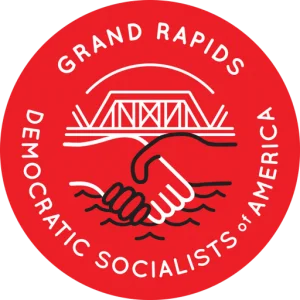

Time is short, act now! Tell you reps to pressure their Republican colleagues to vote NO!
Slightly different versions of the “Big Beautiful Bill” have passed in the House and Senate. Wildly unpopular among the American people, this bill has barely squeaked through Congress. Passing in both the House and Senate by only 1 vote. Now, it goes back to the House. Trump is calling for it to be on his desk for July 4th.
Time is short, act now! Use the form below to tell you reps to pressure their Republican colleagues to vote NO!
NO cuts to SNAP and Medicaid!
NO funding for ICE abductions!
NO handouts for billionaires!
Cuts to vital services are dwarfed by the handouts to billionaires. The “Big Beautiful Bill” would be one of the largest cash grabs by billionaires in world history.
ICE has terrorized communities by abducting people off the street. Masked men have grabbed people off the street and put them in unmarked vehicles. Holding them without charges, deporting them without due process. The “Big Beautiful Bill” will reinvigorate an agency that kidnaps our neighbors.
The “Big Beautiful Bill” makes massive cuts to vital programs. More than 40 million Americans will lose vital help putting food on the table. As many as 17 million poor and disabled Americans will lose their healthcare. Cuts to rural hospitals and nursing homes will leave many without access to medical care.
Many will go hungry and many will die because of this bill. Tell your representatives to use all their power to stop this Big Bullshit Bill!
The post Time is short, act now! Tell you reps to pressure their Republican colleagues to vote NO! appeared first on Grand Rapids Democratic Socialists of America.


The Vermont Socialist - GMDSA newsletter (6/28/25): A propaganda which is accessible to everyone

There's never been a more exciting time to be in DSA. As you may have heard, a democratic socialist recently won the New York City mayoral primary.
33-year-old Zohran Mamdani's unexpected victory over former governor Andrew Cuomo in America's biggest city demonstrates the power of politics that centers the material needs of the working class. Amid numerous reasons for despair, it shows that DSA can offer a path forward. It's a moment of national significance, and now we need to take the model nationwide.
You can play a part by joining DSA and getting involved in your local chapter. Scroll down for our calendar of meetings in July.
You'll notice that it doesn't include a chapter or branch meeting. Instead, we've planned a couple outdoor social events for the summer. One of them is tomorrow (6/29)!


Come to Waterbury Center State Park (177 Reservoir Rd.) at 9:30 a.m. or to Stowe's Sterling Pond Trailhead (6443 Mountain Rd.) at 10 a.m. and spend a day in nature with other socialists. You can hang out with us again on July 20 at Burlington's Oakledge Park (11 Flynn Ave.), where a picnic will begin at 4:30 p.m. Feel free to email us at this address if you have any questions about either event.
We're getting folks together in part because we're trying to raise funds for our chapter's elected delegates in advance of the 2025 DSA National Convention in Chicago, where they'll debate resolutions and help choose a new National Political Committee. If we want our chapter's voice represented in August, we need to make sure that our representatives can afford the trip. You can donate here.
Finally, you may have heard that downtown Burlington is getting a new movie theater in the fall. If you noticed its name or read about its democratic governance, you may guessed that socialists had something to do with it. GMDSA has endorsed Partizanfilm, a cooperative, grassroots project to build a not-for-profit cinema for the people. Consider becoming a member! And please tell them we sent you on their signup form.
GMDSA MEETINGS
🚲 GMDSA's Urbanism Committee will meet on Monday, July 7, at 6 p.m. on Zoom.
🧑🏭 Talk about your job and learn about shop-floor organizing from peers at Workers' Circle (co-hosted by the Green Mountain IWW) on the second and fourth Wednesdays of each month, including July 9, at 6 p.m. at Migrant Justice (179 S. Winooski Ave., Burlington).
🔨 Our Labor Committee will hold its next meeting on Monday, July 14, at 6 p.m. on Zoom.
🗳️ The next meeting of our Electoral Committee will take place on Wednesday, July 16, at 6 p.m. on Zoom.
🏳️⚧️ Our Gender & Sexuality Committee will meet on Monday, July 21, at 7 p.m. on Zoom.
🤝 Find out how you can help our Membership Committee improve recruitment and involvement in our chapter on Tuesday, July 22, at 6 p.m. on Zoom.
🎥 Socialist Film Club will temporarily go remote next month. July's pick is the Italian drama The Working Class Goes to Heaven (1971), available via Solidarity Cinema. After watching it individually at home, we'll discuss it together at Zero Gravity (716 Pine St., Burlington) on Friday, July 25, at 8 p.m.
🍉 Our Palestine Solidarity Committee will meet on Monday, July 28, at 7 p.m. on Zoom.
STATE AND LOCAL NEWS
📰 About 16,500 protesters rallied against President Trump in Burlington on No Kings Day, which may have been the state's most active day of political demonstrations ever.
📰 The Vermont Progressive Party needs a new executive director.
COMMUNITY FLYERS




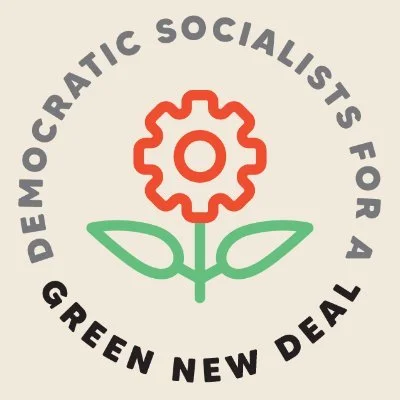

Mass Call: The Fight for a Socialist Green New Deal
Hear from union leaders, DSA campaign organizers, and socialists in office who are continuing the fight for a better future. Given the hostile federal terrain we now face, local pressure campaigns in our communities and bargaining for the common good in our union contracts are the most viable pathways for winning a socialist Green New Deal this decade.
Speakers
- Thea Riofrancos (author, A Planet to Win: Why We Need a Green New Deal)
- Ashik Siddique (DSA National Political Committee, Co-Chair)
- Sarahana Shrestha (Mid-Hudson Valley DSA, Assembly District 103)
- Kelsea Bond (Atlanta DSA, council candidate)
- Alex Brower (Milwaukee DSA, Common Council District 3 representative elect)
- Michael B (Louisville DSA)
- Sam Z (DSA Los Angeles)
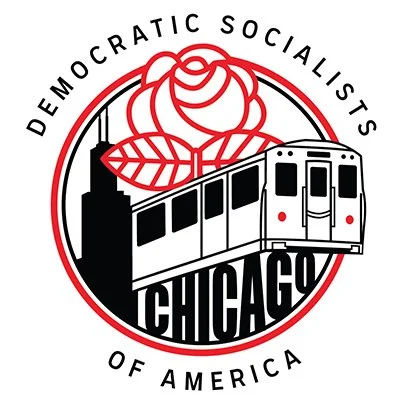

Why Chicago DSA Is Marching in the Pride Parade
In 2023, Chicago DSA’s Chapter Convention was on the same day as Pride. This wasn’t planned, CDSA had selected the Convention date months before Pride announced their date. Former chapter Secretary Marcy wrote a great essay for Midwest Socialist about why she preferred attending a chapter meeting than the city’s highly corporate pride event, which you should all read.
There were plenty of queer and trans people in the room, making democratic decisions at the meeting. We also didn’t make quorum, and it was obvious that some members had chosen (or were working at) Pride instead of doing Robert’s Rules for half an afternoon.
At the beginning of my cochair term, as I was planning out the dates of our quarterly meetings with my fellow cochair, I checked when Pride typically happened each year. After this review, I set one requirement: CDSA’s Convention should not conflict with either Juneteenth or be held on the last Sunday of the month, because that will mean conflicting with the Pride Parade.
I didn’t do this because I wanted to do corporate Pride entryism into the chapter, but rather because Pride brings thousands of people across the Midwest, and we should be embracing opportunities to share our politics with attendees.. Even if the events themselves are depoliticized or corporatized.
In June 2024, CDSA members fanned out across the Chicago Pride Parade route, passing out Crash the DNC fliers and talking to attendees about the critical importance of an arms embargo. We talked to people about socialism, drank Gatorade, and met many other attendees with left and pro labor signs, and had great conversations with people we otherwise would not have met. Amidst the chaos and uncertainty of the Presidential election, being able to dress up in rainbow and socialist swag while talking about our politics lifted our spirits.
This year, Chicago DSA is joining the Gay Liberation Network and Organized Communities Against Deportation (OCAD)’s organized contingent in the Pride march. Attacks on LGBTQ people are more intense than ever, and Pride attendees need to see a distinctly queer contingent bringing left politics in support of immigrants, labor, and Palestine. We will also have members doing crowd canvassing in support of trans patients at Lurie Children’s Hospital.
There will still be floats from large corporations, many from industries that actively harm queer and trans people every day (property management companies, banks, union-busting nonprofits and restaurants, the list sadly goes on). Those groups will march, whether or not we participate, so we might as well take up space in the parade.
This won’t be the first time that Chicago DSA has marched in the Pride parade. The chapter participated in the mid-90’s, when both Chicago DSA, and the Pride Parade were much smaller.
Early Pride events through the 1970s-2000s were more focused on community groups instead of sponsors, and were much more political – because they had to be. Discrimination and abuse by police were rampant, and legally sanctioned. People were dying of AIDS due to the mass indifference of federal policymakers. There were no corporate sponsors because corporations saw LGBTQ people as a brand threat, not a customer base.
The demand that Pride become more of a party, complete with freebies thrown from corporate sponsors did not fall out of a coconut tree – it came about because of demands for LGBTQ people. Many people wanted banks, real estate agencies, and politicians to attend Pride and take their dollars and votes. Pride as a party is made possible due to many different legal protections, including basic local ordinances against “indecency”. If we want Pride to be political, we need to engage with people at Pride and make our case. This year is a good time to do that, because so many people are angry at the Trump administration, and angry at corporate cowardice and an end to long-standing sponsorships for Pride events.
There is no shortage of alternative Pride marches and events seeking to directly challenge Corporate Pride, both across the US and Chicago. In 2020 there was both a mass protest that weaved through North Halsted and ended in Uptown, and a “Drag March for Change”, explicitly demanding an end to racist discrimination in drag act bookings by Chicago venues. However, these events have seen less participants since then, and this year organizers of the “Taking Back Pride” march announced that they were cancelling their planned march for Sunday, June 22nd in order to direct people to join the GLN/OCAD contingent at Pride. Alternate marches and events can create a taste of the better world we want, but they rely on a significant amount of volunteer infrastructure, risk more encounters with police, and often don’t serve the purpose of welcoming new people into the movement.
Join us Sunday, June 29th to either march in the Pride parade or canvass attendees about our Lurie Children’s Hospital letter campaign. If we want to win rainbow socialism, we need to speak to the beautiful rainbow masses at the Pride parade.
The post Why Chicago DSA Is Marching in the Pride Parade appeared first on Midwest Socialist.


The time for fence-sitting, apolitical unionism must come to an end.
Note: posts by individual GMDSA members do not necessarily reflect the views of the broader membership or of its leadership and should not be regarded as official statements by the chapter.
Below is a speech made by Green Mountain DSA labor chair, Andy Blanchet, on June 10th, 2025 at the Burlington, VT ICE OUT protest. The protest brought together people across the Vermont community - from union & migrant workers to retirees and community organizers - to stand in solidarity with the community of Los Angeles, CA in their resistance to government repression.
GMDSA’s Labor Committee recently worked with rank and file union members in putting on a Union Power organizing training in April 2024, and was a key organization in coordinating and organizing the May Day 2025 March in Williston, VT where 2,500 people came out to celebrate international workers’ day and stand in solidarity with Vermont migrant farm workers in their Milk with Dignity picket line at Hannaford Supermarket.
Repeat after me: An Injury to One, is an Injury to all! (x3)
Hello! My name is Andy Blanchet and I am a full-time worker at Howard Center, and speak today as president of our labor union, AFSCME Local 1674, and as chair of the Green Mountain Democratic Socialists of America Chapter’s Labor Committee. I come with an urgent message for fellow working class people and our role in combating Trump’s Authoritarian cruelty as witnessed in LA and beyond. I first want to state clearly: AFSCME Local 1674 stands in solidarity with all who have been kidnapped by ICE and DHS and we demand the immediate release of those currently detained. We stand in solidarity with every Union member on the streets exercising our right to freedom of speech in calling for an end to the cruel ICE raids. These unacceptable state sponsored acts of kidnapping are both horrific and unsurprising from this administration. Unsurprising, considering capitalism’s fundamentally authoritarian nature.
We currently live in a world where bosses who run corporations have full authority over workers. This is an ugly dictatorship of capital - where those who make profits from the blood, sweat, and tears of workers can decide exactly what kind of lives we are allowed to live by exploiting our time and energy for the sake of profit. Not only that, but the capitalist landlords, who pay for their new pools and 2nd homes with our meager wages we break our backs for, decide exactly how much to extort from us in exchange for shelter. Workers have historically worked to combat this dictatorship of the bosses by forming our own labor and tenant unions.
And with that collective organizing, working class people have tried to exercise our natural rights to free speech, organizing, freedom of association, and collective bargaining to win both better wages and working conditions, as well as political change. However, every step of the way, the rich have fought us tooth and nail for even the most meager of wins. They hire union busting lawyers from an industry that reaps profits by convincing employers to keep them on retainer in order to fight their own workers simply pursuing dignity and respect in the workplace. They call the police on striking workers, like they did to Starbucks Workers’ United members during their sit-down strike earlier this year. The rich have even gone so far as to OUTLAW the ability to strike, to withhold our labor, in different industries. That didn’t stop unions like the Newton Teachers’ Association of Newton Massachusetts from organizing a successful, and illegal, strike to win their demands.
But now, it seems, the rich bosses want more. They criminalize working people from speaking out in support of Palestine through the critique of our own country’s complicity in the ethnic cleansing and genocide of the Palestinian people. ICE beat & detained the President of SEIU California, David Huerta, while he exercised his freedom of speech. The rich are willing to target unions, union workers & leaders, and immigrant workers to maintain their full control over our economic, political, and social lives. And it is essential that every union, be they local or international, answer the question: Which side are you on?
The time for fence-sitting apolitical unionism must come to an end. There are numerous examples of unions trying to play-nice with overtly hostile political administrations, thinking this would save them, and it never has. All this does is allow those in power to exercise their will over organized labor and know they can get away with it. Worse than that, the do-nothing Democratic party has used the plight of working class people as their political platform for decades. Workers are not pawns to be used in rhetoric and then discarded when it’s time to make good on policy promises - working people are who have built and sustained society and we deserve money for healthcare, prenatal & child care, education, housing, and food, not money for bombs and deportation! It is well past time for unions, big and small, to recognize these trends and organize to win the future we all deserve.
We can win these demands, and more, if we recognize and internalize that when we are divided, and alone, we are at risk. But when we practice safety through solidarity, we are unstoppable! Look at what organized labor did to energize the working class of South Korea in 2024. By organizing workers in huge companies into strike-ready unions and collaborating with farm workers, Korean workers were able to mobilize and fight back against President Yoon Suk Yeol’s declaration of martial law in a fight for democracy. We, the workers and organized labor, must find the political will to commit to this version of organizing for the common good in order to have a lasting impact. We deserve lives of dignity, honor, love, and justice!
The workers, united, will never be defeated! (x3)
Thank you! Solidarity Forever!
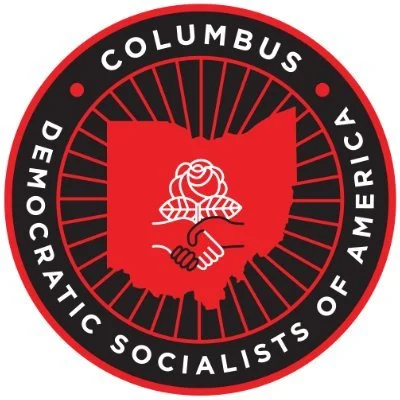

Statement on ICE and Deportations
Columbus DSA condemns, in the strongest possible terms, the actions of President Trump and his administration, the United States armed forces, ICE, and the LAPD in their relentless brutality against peaceful protestors fighting to protect their communities from the thugs abducting their friends, family, and neighbors. We condemn the violence of ICE and their campaign of mass deportations that has come to our city of Columbus. On June 3rd ICE arrested Leonardo Fausto at a court hearing for a dismissed misdemeanor traffic violation. Fausto has lived in Columbus legally for 4 years while waiting to be granted asylum. Ohio senators have also passed a bill that will require public officials to allow the arrest of suspected undocumented immigrants with or without warrants, while other Ohio lawmakers have proposed the “America First Act”, making it a felony to be in Ohio undocumented. We stand in unshakable solidarity with our undocumented neighbors: no one’s existence is illegal.
The recent protests in Los Angeles and other cities demonstrate that the American people are aware of the cruelty that this administration inflicts upon our families, our neighbors, and people in our communities, and we demand that these abuses stop.
Left unchecked, this administration, alongside ICE and local law enforcement, will continue to hide what the ‘land of the free’ has become from the world. They obscure their names and faces so that no one knows who to hold accountable for their crimes, all while they vanish our neighbors, family, and friends. ICE has only existed since 2003 but is being used like the Gestapo of Nazi Germany to create terror among us. We have lived without their presence for most of our existence, and we don’t need them now. To that end, we demand the following from our own community of Columbus:
We demand ICE be abolished. We demand that undocumented citizens be given amnesty and a swift path to citizenship. And we call for the immediate release of every person that ICE has arrested in LA and across the nation.
We demand that Columbus City Council end their contracts with ICE, make Columbus a sanctuary city, and protect its residents from these illegal abductions.
Columbus DSA will continue to fight for the power of the working class and the freedoms of people all over the world, immigrants or not. We will not stand by as the people of our community are abused by state violence. An injury to one is an injury to all. Free the prisoners, abolish ICE, and end the authoritarian regime currently in power.



Lessons from the McCarthy Red Scare
We are experiencing the most sustained and broad attacks on US democracy since the McCarthy period. MAGA has put together a fascist coalition of white supremacist, reactionary nationalists, Christian fundamentalists, libertarians, and techno-authoritarians, and they are on an offensive against the 20th century. All the gains of labor, civil rights, women, and the LGBTQ community are under assault. The fascists intend to fundamentally restructure institutional democracy and to impose a straitjacket on civil society. This closely parallels the McCarthy period, and there are important similarities and differences between now and then, and lessons we can draw.
My uncle (Fred Fine) was on the leading committee of the Communist Party (CP) and closely involved in discussions about organizing an underground apparatus of safe houses for Party leaders. Fine himself was assigned to the underground, and was there for four years. During that time, he was on the FBI’s Ten Most Wanted List, and never once spoke with his wife or young son. My father, who had fought in the Spanish Civil War, was threatened with deportation, and the FBI threatened to declare my mother “unfit” and told her they would have her children (ages 6 and 11) put into foster homes without visitation rights. Thousands suffered similar threats and intimidation, key leaders were jailed, some cadre turned informant, and Ethel and Julius Rosenberg were executed.
When the Party leadership discussed how to respond to McCarthy, there were two key assumptions: fascism was imminent and war with the Soviet Union inevitable. The similarities to today are striking. Many people feel fascism is imminent and war with China inevitable. The CP drew a number of conclusions from these assumptions that had drastic consequences for its members and mass organizing.
First, they purged members they considered untrustworthy or politically weak. And perhaps more damagingly, the Party concluded repression would be worst in the South, and so shut down all its southern districts and withdrew its organizers after 25 years of outstanding work organizing the South. When my parents divorced, my mother left Chicago and went to Florida with my brother and me to join a close friend—a woman who had been a nurse in the Spanish Civil War, working with the world famous doctor Norman Bethune. My mother was kicked out of the Party for moving to the South, and was only let back in when we moved to California. That didn’t stop the FBI from following her to Florida and getting her fired from several jobs.
My mother kept a journal of her time in Florida. Here is one short excerpt of her experience:
TODAY IS MY BIRTHDAY…35 years. Nobody knows except the FBI. My gift from them
The author’s mother, Rose Fine, (center) at a protest in Chicago (c. 1955)
was once again being fired. This time from a job short lasted.
But I truly enjoyed working as proofreader on the St. Petersburg Times.
Well, at least I was let go early in the day. So now I’m home with enough time to
change into my waitress uniform. And time enough left to wait for Paulie to come home
from school. Young Jerry is only 4 and Paulie 9. The best birthday.
We’ll be playing a few games of baseball before I take off for my night shift.
There sits the limousine of the FBI. Another obstacle of fears,
confusion of what the future holds. This is the time for courage and bold adventures.
For it is now, I have come to understand, and someday so will my sons.
Of that I’m confident. For my mother’s heart tells me so.
The Party went to great lengths to set up an underground apparatus. This had at least two levels: the most secure, in which eight national leaders were sent into hiding, and a less secure state and city underground into which hundreds of local leaders were assigned. This eliminated many of the best organizers from doing mass work. Moreover, local underground networks were largely penetrated by the FBI. Even at my uncle’s level, four of the eight leaders were captured by the FBI. Although he had a number of close calls at different safe houses, he held out until the Party decided to come out of hiding and he eventually stood trial with several other leaders in New York.
When the Party’s first line of leadership (William Foster, Eugene Dennis, and others) went on trial, they tried to defend themselves by educating the jury about the true meaning of Marxism-Leninism. The result was prison time for all. On my uncle’s wanted poster (up in post offices throughout the country) was the following charge: “unlawfully conspiring with other persons to knowingly teach and advocate the duty and necessity of overthrowing and destroying the government of the United States by force and violence.” Of course, the Party never told members to arm themselves, they never organized armed cells, nor did they have plans for an armed insurrection. They did teach about the armed revolution in Russia, the history of capitalist violence, and the ultimate need to defend any socialist electoral victory from a reactionary counterrevolution.
FBI “Most Wanted” Poster for the author’s uncle, Fred Morris Fine
By the time my uncle stood trial, the Party had switched its defense strategy to asserting the freedoms of speech, association, and assembly. There is a difference between speech and advocacy and actively organizing acts of violence. This focus on civil liberties proved more successful with the courts. In 1957 the Supreme Court ruled that the First Amendment protected radical speech, overturning the conviction of 14 Communist Party officials and effectively ending the use of the Smith Act to target leftists for their political beliefs. A series of subsequent rulings forbade the use of blacklists and other methods of political persecution, which helped bring about the end of the Second Red Scare. However, the proceeding period of internal debates and bitter feelings resulted in about half the remaining members leaving the Party by 1957.
Lessons for Today
During the McCarthy period the ruling class was united in its efforts to destroy the left. From conservatives to liberals, Republicans to Democrats, a united front was made impossible. Even the ACLU purged Elizabeth Gurley Flynn from its board for being in the CP. Furthermore, social democratic union leaders like Walter Reuther were more than happy to rid labor of Communists. Loyalty oaths were demanded at universities, public schools, unions, Hollywood, and various industries. Public show trials were held by the House Un-American Activities Committee in cities across the country. Many former friends of the Party were running scared.
But while the persecution the Party faced was real, “the almost fatal blow,” as Party leader Peggy Dennis later wrote in her Autobiography of an American Communist, “was self-inflicted.” The decision to shutter its Southern districts and take the Party leadership underground anticipated a level of repression far greater than that which materialized. Designed to protect the Party from the advent of fascism and world war, it instead deprived mass struggles of thousands of their most militant organizers and activists, weakened the labor movement, cut off key linkages with the Black freedom struggle, and contributed to a decline of CPUSA membership from 80,000 in 1945 to less than 15,000 by 1957.
Today, conditions are in some important ways more favorable for us than during the McCarthy era. The ruling class is split. Already we see mass rallies and protests. Alexandria Ocasio Cortez and Bernie Sanders, Hands Off, and May Day marches have already gathered millions in opposition to fascism. Courts as of yet have often ruled against Trump. A united front is not only possible, but is in early formation.
In this moment, many leftists are concerned about safety and security – understandably. The harms caused by Trump’s repressive regime are real. But a key lesson from the McCarthy Era is that we must not let our fear of persecution isolate us from the masses and from mass movements. We can and must continue to organize, even as we take measures to help keep ourselves and each-other safe. The following are some suggestions for this period:
- Stay rooted to mass work, defend our friends and allies, and ask them to defend us.
- Defend the Bill of Rights, civil society, civil liberties, and civil rights for all.
- Stay calm but be aware of security.
- Make sure your financial records—particularly organizational finances—are in order.
- Organizations should have a house counsel, and individuals should always keep the number of a lawyer with you.
- Never write on social media or in email what you don’t want read back to you in court.
- Vocally reject all proposed violent acts at public meetings
- NEVER TALK TO THE FBI. Legally you don’t have to, but if you lie, you’re committing a federal crime. So, NEVER TALK TO THE FBI.
This is the time for courage and bold adventures. Collectively, our actions now will help determine what the future holds.
The post Lessons from the McCarthy Red Scare appeared first on Midwest Socialist.


Your National Political Committee newsletter — Struggle and Joy
Enjoy your June National Political Committee (NPC) newsletter! Our NPC is an elected 18-person body (including two YDSA members who share a vote) which functions as the board of directors of DSA. This month, standing against ICE, celebrating Pride and Juneteenth, preparing for Convention, and more!
And to make sure you get our newsletters in your inbox, sign up here! Each one features action alerts, upcoming events, political education, and more.
- From the National Political Committee — Struggle and Joy
- RSVP for The Fight for a Socialist Green New Deal Call Wednesday 6/25!
- Monthly Convention Update — Secondary Amendment Submissions, Observer Registration, Volunteering at Convention, and More!
- Save the Date: DSA Fund’s A World To Win Fellowship Nominations Open Wednesday 6/18
- Fundraising Committee Membership Applications are Open!
- Send Chapter News to Democratic Left
- Socialist Forum 2025 Convention Special Issue — Call for Pitches
From the National Political Committee — Struggle and Joy
Things are scary out there. Here in the States, the Trump administration and their ICE jackboots are throwing union leaders in jail on ridiculous, inflated charges, raiding workplaces from coast to coast, ripping healthcare away from trans folks, and deploying the US military in our cities. Internationally, Israel continues to starve and massacre Palestinians and seems to be starting, with bottomless US financial support, a war with Iran. This Saturday, June 14, in Washington DC, Trump is hosting a $92 million military parade from the Pentagon to the White House for his birthday — a victory march meant to celebrate his agenda of war and destruction, rally far-right support, and project strength to the world, while massively wasting taxpayer dollars amid his government’s life-threatening cuts to basic social services.
But when the working class is under attack, what do we do? Stand up, fight back!
DSA unequivocally stands with our immigrant neighbors — and not just with words. Our members are holding strong with our communities from Los Angeles to Boston, from San Antonio to Seattle, and especially mobilizing with our labor unions in response. We will be out in numbers this weekend demanding the better, safer, kinder, more just world that we know is possible.
Against Trump’s militarized birthday parade on June 14, the people of Washington DC are choosing to reject fear, and instead will celebrate local culture, community, and connections to one another at #DCJoyDay.
In New York City, Zohran Mamdani’s democratic socialist campaign for mayor keeps surging in momentum, and is now within striking distance of the flagrantly corrupt frontrunner Andrew Cuomo, with just under two weeks to go until the primary election. The ruling class of the world’s wealthiest city is nervous — they don’t understand political success without their own big money strings attached. In a debate last night, Cuomo even said “we wonder who’s funding DSA?” The answer is you — and tens of thousands of working class members giving whatever we can in dues, to punch way above our weight together!
If you’re not sure where to start taking action, here are some steps you can take:
- join our Boycott Avelo campaign to hold the companies that collaborate with these fascist ICE deportations accountable
- join our campaigns to Boycott Chevron
- RSVP for our Labor vs ICE call Wednesday 6/18
- organize Labor for an Arms Embargo, to make it clear that we will not stand for genocide
Our class enemies know that all of these issues are connected; we must, too.
In the midst of the fear and uncertainty, we also remember that June is a month to revel in the joy of victory over fascist forces. Pride and Juneteenth celebrations are both steeped in that tradition: Pride started when trans and queer folks refused to let a fascist police force take away their community space and collective joy; Juneteenth celebrates the end of chattel slavery in the United States, and comes with a reminder that liberation is incomplete — none of us are free until we are all free.
We encourage you to let these celebrations help you remember the long game here. These fights are difficult, the enemies are terrifying and extremely well-equipped, but when we organize, when we use and expand our collective strength, when we stand in solidarity, then we are more powerful than anything the ruling class can throw at us, and the fight for socialism is a fight for a better world for everyone. There is light at the end of the tunnel; there is joy at the end of the struggle. Let that fuel you.
¡Hasta la Victoria!
Megan Romer and Ashik Siddique
DSA National Co-Chairs
P.S. We want to send a warm welcome to our newest DSA organizing committees: Upstate SC, Owensboro (KY), The Shoals (AL), and Pinal County (AZ); and a special shout-out to our newest full-fledged chapters: Rock River DSA (WI) and St. Cloud DSA (MN)!
RSVP for The Fight for a Socialist Green New Deal Call Wednesday 6/25!
Join Wednesday 6/25 at 8pm ET/7pm CT/6pm MT/5pm PT us to hear from union leaders, DSA campaign organizers, and socialists in office who are continuing the fight for a better future. Given the hostile federal terrain we now face, local pressure campaigns in our communities and bargaining for the common good in our union contracts are the most viable pathways for winning a socialist Green New Deal this decade.
Monthly Convention Update — Secondary Amendment Submissions, Observer Registration, Volunteering at Convention, and More!
Submit or sign on to an Amendment to an existing Resolution, Constitution/Bylaws Amendment, or Platform Amendment via our Convention Hub! Amendments to proposals are also processed through the Portal on our national Discussion Forum. The deadline for secondary amendments is Sunday 6/29. You can find more information on our proposals page here.
And Convention registration is now open! For Delegate and Alternate Registration, Delegation Chairs will receive registration information after their chapter’s election results have been submitted. The election results will be checked for any errors or expired memberships. Any issues found must be resolved before registration information is provided, and we will provide you with directions to resolve it. You can find registration information on the Convention website here. Early bird delegate registration is $175. The deadline for early bird registration is Sunday 6/22.
Observer registration is open as well. DSA members in good standing can attend the Convention in a non-voting capacity as an Observer. The Observer registration fee is $225.
Observers can view plenaries and deliberation on proposals and attend breakout sessions. Observers are not eligible for scholarship funding. For questions, please email DSACon@dsausa.org.
To make sure all delegates and alternates can fully participate, scholarships will be available through our Solidarity Fund. If a duly elected Delegate or Alternate needs assistance with registration fees, travel costs, housing, or food assistance they may apply for a scholarship. Please see your Delegation Chair for details. The scholarship deadline has been extended to Sunday 6/22. And as a socialist organization, we support each other! To help sponsor a comrade, you can give here.
This year’s Convention will be one of the largest member gatherings in DSA’s history. The check-in process, debate sessions, and our voting tools need to run smoothly for our 1,500+ attendees. If you are a DSA member in good standing who can provide support during the Convention, in any of these areas, please check out the shifts we have available at the form here!
Are you an artist, maker, creator, collector, or just a cool comrade with an even cooler item that you’d love to donate to a good cause? Please consider donating to our 2025 DSA Convention fundraiser live auction! The submission deadline is Monday 6/30. We’re looking for art pieces, handmade items, one-of-a-kind socialist collectibles, experiential gifts (a weekend stay at a vacation property, a dance lesson, concert tickets, a tattoo, perhaps?) or some funky or creative thing we haven’t even thought of! Funds raised will go directly to Convention costs, helping it stay affordable for working-class comrades from around the country.
And say hi to comrades in the Convention Solidarity Journal! This year’s National Convention will feature a printed Solidarity Journal that will be distributed to all Convention attendees and shared online. You, your chapter, working group, or committee can place an ad in the Solidarity Journal to send a message of solidarity or of celebration to your chapter, work, or comrades. The deadline to purchase an ad is Friday 7/18.
Please note that Solidarity Journal messages advocating for or against any convention proposal, NPC candidate, slate, or DSA caucus will not be accepted. Journal space is available in three sizes, plus text-only solidarity messages. Ads should be sent as PNG, JPG, or TIFF files, color or black and white. You can find more details and buy your ad here.
Save the Date: DSA Fund’s A World To Win Fellowship Nominations Open Wednesday 6/18
Nominations for DSA Fund’s inaugural A World To Win fellowship open Wednesday, June 18th!
Organizers in every state are bringing new communities into the movement for democratic socialism, often with little support or recognition. They’re organizing new DSA chapters or bringing new comrades into growing chapters. They’re organizing workers or building tenant unions. They’re fighting for immigrant rights and trans rights. They’re bringing democratic socialist messages to new audiences, whether knocking on doors or posting TikToks. They are organizing everywhere, online and offline, small towns and big cities, red states and blue states.
DSA Fund’s A World To Win fellowship is for organizers doing groundbreaking work to bring new communities into the movement for democratic socialism. The fellowship includes a $5,000 award, a set of virtual workshops with democratic socialist luminaries, and opportunities to share their work with comrades across the country. Start thinking today of who you want to nominate!
Fundraising Committee Membership Applications are Open!
“Yes, that campaign sounds cool, but how are we going to pay for it?” If this question doesn’t scare you a bit and you have some experience fundraising either in your DSA chapter or outside DSA, you might just be a good fit for the DSA National Fundraising Committee! This committee helps us fundraise to keep DSA solvent at a national level, through things like dues campaigns, one-off fundraisers, and small-dollar donor asks, as well as helping chapters learn to fundraise for their own work. Whether your experience is in event planning, non-profit giving, fundraising communications, or anything of the like, or maybe you’ve just got a track record of throwing great fundraisers for your chapter, apply to become a member of the Fundraising Committee today!
Send Chapter News to Democratic Left
Our member publication Democratic Left is looking for news items for “Chapter & Verse,” its monthly wrap-up of chapter news. Check out the April edition for examples of the chapter campaigns, events, and accomplishments DL hopes to cover in this feature.
Items can be submitted using the form available here. The editors want to highlight the amazing work DSA chapters across the country are accomplishing. Chapters interested in showcasing their efforts regularly may want to consider designating correspondents who will regularly submit items. Questions can be sent to edboard@dsacommittees.org.
Socialist Forum 2025 Convention Special Issue — Call for Pitches
As the DSA Convention approaches, Socialist Forum is accepting pitches for pieces debating the merits and demerits of the resolutions up for debate at our national convention in August on a rolling basis. We are interested in pitches of essays of a variety of lengths (preferably between 1,000-2500 words) tackling proposals and issues related to the upcoming convention. This could be an essay discussing the specificities of DSA’s position on anti-Zionism or a pitch to discuss or elaborate on a particular proposal having to do with DSA supporting more electoral fights across the country. You can find last Convention’s issue here for reference. Please email submissions or questions to socialistforum@dsausa.org.
The post Your National Political Committee newsletter — Struggle and Joy appeared first on Democratic Socialists of America (DSA).
